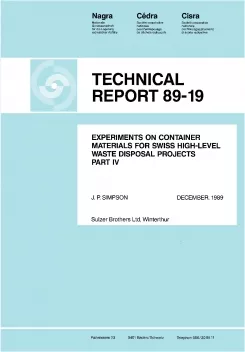
Technical Report NTB 89-19
Experiments on container material for Swiss high-level waste disposal projects Part IV
One concept for final disposal of high-level waste in Switzerland consists of a repository at a depth of 1000 to 1500 m in the crystalline bedrock of Northern Switzerland. The waste will be placed in a container which will be required to function as a high integrity barrier for at least 1000 years.
This report is the fourth and last in the current series dealing with the evaluation of potential materials for such containers. Four materials were identified for further evaluation in the first of these reports: they were cast steel, nodular cast iron, copper and Ti-Code 12.
Copper and cast steel were chosen for further evaluation without prejudice as to the technical merits of the other two materials. The bulk of the experimental work concentrated on the latter material as the data basis for the adoption of copper as a candidate material was more complete.
The main effort so far reported concentrated upon establishing that the general corrosion and the localized corrosion rates of cast steel in groundwaters of the type expected are acceptable. The long term corrosion rate is expected to be less than 20 μm/a and the conditions such that large local variations in corrosion rate or pitting are unlikely.
This report touches upon two other important aspects. The first is the problem of demonstrating that cast steel containers will not fail by stress corrosion cracking. The second is the evolution of hydrogen produced by the reduction of water; the corrosion product hydrogen may be a problem if it is produced faster than it can escape as a dissolved species by diffusion, i.e. if gas pockets or bubbles are formed which could lead to pressure build-up or alter the near-field transport processes by displacement, venting or buoyancy effects.
The experimental results on pre-cracked specimens revealed no susceptibility of cast steel to stress corrosion cracking under model repository conditions. No crack growth was detected on compact DCB specimens exposed in aerobic and anaerobic groundwaters at 80 and 140°C for 16 – 24 months. This suggests that the maximum possible crack growth rates are below 0.1 mm/a or incubation times are exceptionally long under all test conditions. Constant extension rate test results showed a possible effect of inclusions on stress corrosion behaviour. Cast steel remains a candidate material for high-level waste containers.
As expected from thermodynamic considerations no hydrogen could be detected from copper immersed in model groundwaters at 50°C.
Hydrogen is evolved from corroding steel under anaerobic conditions. The highest steady state rate observed in a model groundwater was 2.5 ml (NTP) × m-2 × h-1 at 50°C in the model Böttstein groundwater, corresponding to a corrosion rate of 7 μm/a; it was lower at both 25°C and 80°C. Higher values were however obtained in dilute bentonite slurries. The hydrogen evolution rate is independent of chloride concentration between 0 and 8000 mg/l but falls by a factor of 10 on increasing the pH from 7 to 10.
Hydrogen evolution due to corrosion of iron or steel in waste repositories has to be considered in any safety analysis; the amounts produced can be significant.
The report concludes the current phase of corrosion testing for Swiss high-level waste repositories. Evidence to date suggests that both cast steel and copper are suitable container materials. Because the corrosion behaviour of both materials is sensitive to service conditions, in particular length of the aerobic phase, groundwater chemistry and temperature, further testing should be undertaken when a specific site has been identified.
